This set of Electrical Machines Questions and Answers for Entrance exams focuses on “Efficiency of Synchronous Machines”.
1. The short circuit load losses is/are ______________
a) direct load loss and stray load losses
b) direct load loss
c) stray load losses
d) field current loss
View Answer
Explanation: Short circuit losses comprise of direct load loss and stray losses too.
2. The open circuit voltage and open circuit core loss variation is?
a) 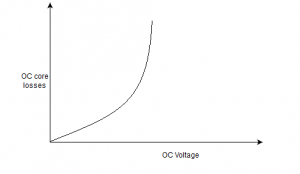
b) 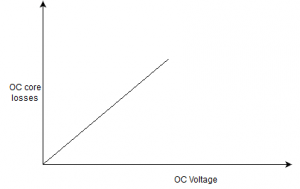
c) 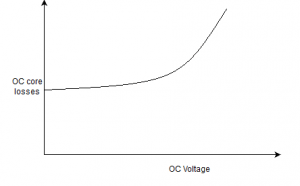
d) 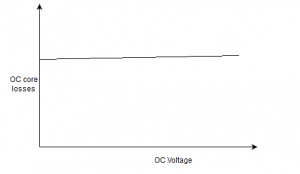
View Answer
Explanation: Core losses vary as a square of the voltage.
3. Rotational losses vary as follows with respect to field current.
a) 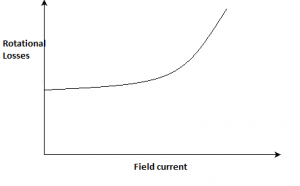
b) 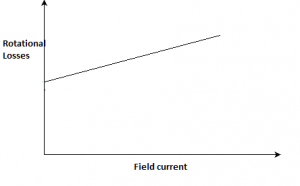
c) 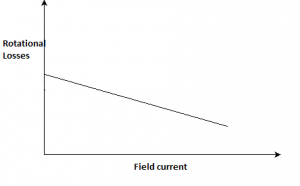
d) 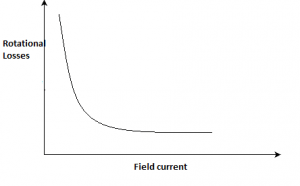
View Answer
Explanation: The y-intercept depicts the friction and windage losses.
4. A 100 KVA, 400V, 3-phase, star connected alternator due to the following data:
Friction and windage losses = 340W Open circuit core loss = 480W Rf = 180ohms, ra = 0.02ohms.
The voltage applied to the field winding is 220V. The short circuit load loss at half full load is?
a) 258W
b) 268W
c) 480w
d) 340W
View Answer
Explanation: SC losses at half load = 3*((Ia/2)2)*ra
= 3*((131.22/2)2)*0.02
= 258.3 A.
5. A 100 KVA, 400V, 3-phase, star connected alternator due to following data:
Friction and windage losses = 340W Open circuit core loss = 480W Rf = 180ohms, ra = 0.02ohms.
The voltage applied to the field winding is 220V. The field current loss will be?
a) 270W
b) 258W
c) 480W
d) 250W
View Answer
Explanation: Field circuit loss = 220^2/180 = 169W
6. A 100 KVA, 400V, 3-phase, star connected alternator due to following data:
Friction and windage losses = 340W Open circuit core loss = 480W Rf = 180ohms, ra = 0.02ohms.
The voltage applied to the field winding is 220V. The efficiency of the machine at half load is?
a) 96.7%
b) 95%
c) 94.2%
d) 97
View Answer
Explanation: Total losses at half load = 340+480+258+268.9 = 1347W
Efficiency = 1-(1347/40000+1347)
= 96.47%.
7. A 100 KVA, 400V, 3-phase, star connected alternator due to following data:
Friction and windage losses = 340W Open circuit core loss = 480W Rf = 180ohms, ra = 0.02ohms.
The voltage applied to the field winding is 220V. The load losses at full load is?
a) 1033W
b) 500W
c) 540W
d) 940W
View Answer
Explanation: Short circuit losses at full load = 3*(131.22)2*0.02 = 1033W.
8. A 100 KVA, 400V, 3-phase, star connected alternator due to following data
Friction and windage losses = 340W Open circuit core loss = 480W Rf = 180ohms, ra = 0.02ohms.
The voltage applied to the field winding is 220V. Efficiency at full load is?
a) 97%
b) 96.5%
c) 92%
d) 95%
View Answer
Explanation: Total losses at full load = 340+480+1033+268.9 = 2122W
Efficiency = 1 – (2122/2122+80000) = 97.4%.
9. The given variable losses are 5kW fr a 500 KVA, 11 kV, 3-phase star connected alternator having armature resistance of 4 ohms. Calculate the current at which maximum efficiency occurs?
a) 20.4A
b) 10.2A
c) 40A
d) 26A
View Answer
Explanation: I2=5000/3*4
I = 20.4 A.
10. The given variable losses are 5kW fr a 500 KVA, 11 kV, 3-phase star connected alternator having armature resistance of 4 ohms. Calculate the full load armature current per phase.
a) 26.24 A
b) 20.41 A
c) 79 A
d) 40 A
View Answer
Explanation: I = P/1.73*V = 5000/1.73*11000 = 26.24 A.
11. A synchronous machine with its field winding on stator and polyphase armature winding on rotor. At steady state, its air gap field is?
I. stationary w.r.t. stator II. rotating at double the speed Ns w.r.t. rotor III. rotating in direction opposite to rotor
a) I, II, III
b) I
c) II, III
d) II, I
View Answer
Explanation: All the statements are correct.
12. A synchronous machine with its field winding on rotor and polyphase armature winding on stator. At steady state running condition, its air gap field is?
a) rotating at synchronous speed w.r.t. stator
b) stationary w.r.t. rotor
c) rotating in the direction of the rotor rotor rotation
d) all of the mentioned
View Answer
Explanation: As the field is on the rotor, the field will be set up w.r.t. rotor.
13. Consider a 3-phase cylindrical-rotor alternator.
A. E.m.f. generated by armature reaction lags armature current by 90°. B. Air gap voltage leads the field flux by 90° C. Air gap voltage lags the field flux by 90° D. Armature reaction mmf lags the field flux by (90°+ internal p.f. angle)
a) A, B, D
b) A, C, D
C) B, D
D) C, D
View Answer
Explanation: Air gap voltage will lag the field flux by 90° to generate the emf.
14. In a 3-phase cylindrical-rotor alternator, synchronous reactance is sum of _____________
a) mutual and leakage reactance
b) magnetizing and leakage reactance
c) magnetizing and mutual reactance
d) mutual, magnetizing and leakage reactance
View Answer
Explanation: Xs = magnetizing reactance + leakage reactance.
15. The reactive power output of a synchronous generator is limited by _________
a) armature current and field current
b) field current and load angle
c) load angle and excitation
d) armature current only
View Answer
Explanation: Q=f(Ia,If).
Sanfoundry Global Education & Learning Series – Electrical Machines.
To practice all areas of Electrical Machines for Entrance exams, here is complete set of 1000+ Multiple Choice Questions and Answers.
If you find a mistake in question / option / answer, kindly take a screenshot and email to [email protected]
- Check Electrical Machines Books
- Practice Electrical & Electronics Engineering MCQs
- Check Electrical & Electronics Engineering Books
- Practice Electrical Engineering MCQs
- Apply for Electrical Engineering Internship
